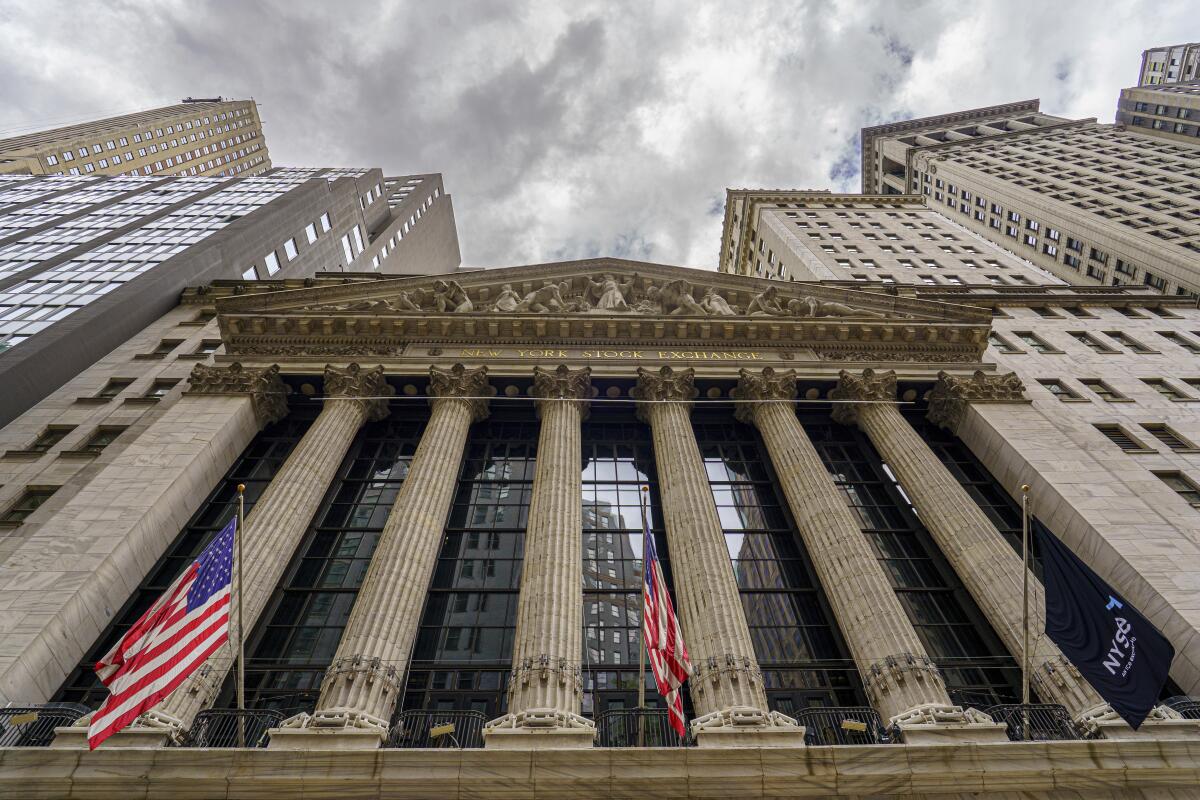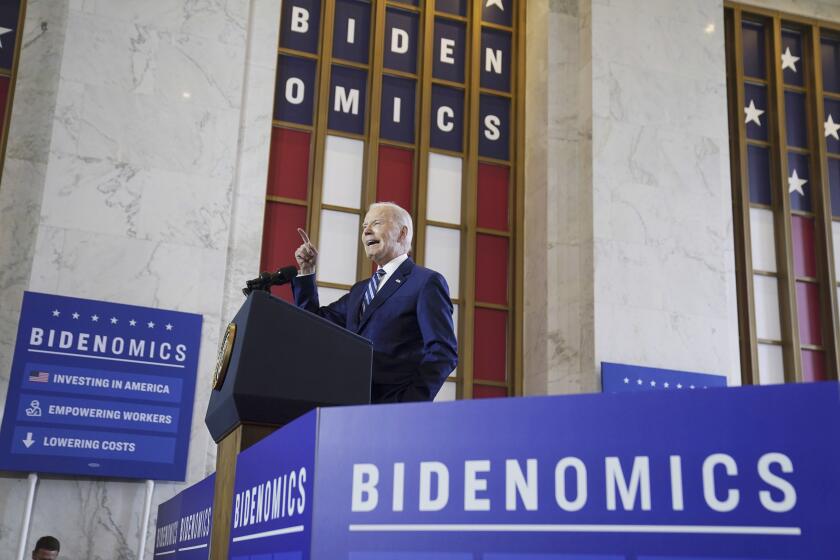Wall Street stumbles in mixed trading as Big Tech stocks drop again

- Share via
Wall Street slipped in mixed trading Thursday as the threat of high interest rates continues to dog major tech stocks.
The Standard & Poor’s 500 index fell 14.34 points, or 0.3%, to 4,451.14 for its third straight loss. The Nasdaq composite was hit particularly hard by the drop for tech stocks, and it sank 123.64 points, or 0.9%, to 13,748.83.
The Dow Jones industrial average held up better than the rest of the market because it has less of an emphasis on tech, and it rose 57.54 points, or 0.2%, to 34,500.73.
Stocks felt pressure from the bond market, where yields rose earlier in the week after a report showed growth for U.S. services industries accelerated more last month than economists expected. Yields remained high after a report Thursday said fewer U.S. workers applied for unemployment benefits last week than expected.
Although such reports are encouraging for the economy, indicating a long-predicted recession is not near, they could also keep conditions humming strongly enough to push upward on inflation.
The Federal Reserve has already hiked its main interest rate to the highest level in more than two decades in hopes of slowing the economy enough to drive inflation back down to its target. It’s come close, and inflation has cooled from its peak above 9% last summer. But the worry is that the last percentage point of improvement may be the toughest for the Fed.
Despite more than a year of widespread warnings that a recession was near, America’s economy is, if anything, accelerating.
“Yes, the economy has slowed and inflation has cooled, but employment continues to be a thorn in the side of the Fed, which has made softening the jobs market the cornerstone of its inflation battle,” said Mike Loewengart, head of model portfolio construction at Morgan Stanley Global Investment Office.
High interest rates drag down prices for every kind of stock. But they tend to most hurt stocks of technology companies and others bid up on expectations for high growth far in the future. Many of those stocks also tend to be the most influential on the S&P 500 because they’re the biggest.
Apple is the dominant force on Wall Street because it’s the most valuable stock, and it fell 2.9% to follow up on its 3.6% drop a day before.
Nvidia sank 1.7% to bring its loss for the week so far to 4.7%. It and a cohort of other stocks in the artificial-intelligence industry have soared this year on expectations that AI could mean explosive future growth in profits.
C3.ai tumbled 12.2% after it said late Wednesday that it no longer expects to be profitable in its final fiscal quarter of the year, as it invests more in opportunities around generative AI. Analysts also pointed to disappointing profit margin levels for the company during its latest quarter, which was the first of its fiscal year.
Although most stocks on Wall Street fell, several helped to limit the losses.
Hiltzik: Bidenomics has been a boon for working-class voters. Why don’t they give him credit?
Inflation is down sharply, employment is holding steady and GDP is growing. But Americans are still blaming Biden for a lousy recovery.
WestRock, a maker of containerboard and other packaging, rose 4.2% after Smurfit Kappa Group said it was in discussions to combine the two companies and keep its headquarters in Dublin.
Power companies and other stocks seen as steadier investments also held up better than the rest of the market. Utility stocks in the S&P 500 rose 1.3% as a group. That was nearly double the gain of any of the other 10 sectors that make up the index.
In the bond market, the yield on the two-year Treasury initially jumped after the unemployment report but then eased as the day progressed. It slipped to 4.95% from 5.03% late Wednesday, but it remains above the 4.88% level where it started the week. The two-year Treasury yield tends to track expectations for the Fed.
Traders still mostly expect the Fed to stand pat on interest rates at its next meeting later this month. But they’re betting on a roughly 45% chance of another increase by the end of the year, according to data from CME Group.
The yield on the 10-year Treasury, which is the centerpiece of the bond market and helps set rates for mortgages and other important loans, fell to 4.24% from 4.30% late Wednesday.
In stock markets abroad, indexes fell in China following the latest set of discouraging data on the world’s second-largest economy. Hong Kong’s Hang Seng dropped 1.3%, and stocks in Shanghai fell 1.1% after a report said China’s exports fell from year-ago levels for the fourth straight month.
City Councilwoman Heather Hutt recently introduced a motion to ban cashless retail businesses in Los Angeles. Whether that’s a good thing depends on whom you ask.
Its economic recovery has fallen well short of expectations after it removed anti-COVID restrictions. That has removed a big engine of growth for the global economy, but it’s also helped to take some pressure off inflation worldwide.
AP writers Matt Ott and Elaine Kurtenbach contributed to this report.
More to Read
Inside the business of entertainment
The Wide Shot brings you news, analysis and insights on everything from streaming wars to production — and what it all means for the future.
You may occasionally receive promotional content from the Los Angeles Times.













